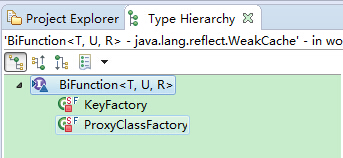本文主要是介绍java -- java.lang.reflect.proxy分析,希望对大家解决编程问题提供一定的参考价值,需要的开发者们随着小编来一起学习吧!
- proxy使用
- 实例1
- 实例2
- 简述
- 应用场景
- 分析javalangreflectProxy
- 静态方法
- 源码
proxy使用
实例1
http://www.cnblogs.com/linjiqin/archive/2011/02/18/1957600.html
实例2
/*
*Copyright (c) 2016, gp.inc and/or its affiliates. All rights reserved.
*/
package com.proxy.demo2;import java.lang.reflect.InvocationHandler;
import java.lang.reflect.Method;
import java.lang.reflect.Proxy;
import java.util.ArrayList;
import java.util.Arrays;
import java.util.Collection;public class ProxyStudy {@SuppressWarnings("all")public static void main(String[] args) throws Exception {ClassLoader loader = Collection.class.getClassLoader();Class<?>[] interfaces = new Class[] { Collection.class };InvocationHandler h = new InvocationHandler() {// proxyBuildColl是对ArrayList进行代理ArrayList target = new ArrayList();public Object invoke(Object proxy, Method method, Object[] args) throws Throwable {System.out.println(method.getName() + "执行之前...");if (null != args) {System.out.println("方法的参数:" + Arrays.asList(args));} else {System.out.println("方法的参数:" + null);}Object result = method.invoke(target, args);System.out.println(method.getName() + "执行之后...");return result;}};Collection proxyBuildCollection2 = (Collection) Proxy.newProxyInstance(loader, interfaces, h);proxyBuildCollection2.add("abc");proxyBuildCollection2.size();proxyBuildCollection2.clear();proxyBuildCollection2.getClass().getName();}
}
简述
动态代理,代理一个对象,间接执行相关操作,并且在执行操作前后可以增加额外操作,如日志。
应用场景
spring框架AOP中核心采用动态代理
org.springframework.aop.framework.CglibAopProxy
org.springframework.aop.framework.JdkDynamicAopProxy
两种动态代理的实现。
分析java.lang.reflect.Proxy
静态方法

方法newProxyInstance 是我们经常用到的,返回目标对象。
Collection proxyBuildCollection2 = (Collection) Proxy.newProxyInstance(loader, interfaces, h);源码
@CallerSensitivepublic static Object newProxyInstance(ClassLoader loader,Class<?>[] interfaces,InvocationHandler h)throws IllegalArgumentException{if (h == null) {throw new NullPointerException();}final Class<?>[] intfs = interfaces.clone();final SecurityManager sm = System.getSecurityManager();if (sm != null) {checkProxyAccess(Reflection.getCallerClass(), loader, intfs);}/** Look up or generate the designated proxy class.*/Class<?> cl = getProxyClass0(loader, intfs);/** Invoke its constructor with the designated invocation handler.*/try {final Constructor<?> cons = cl.getConstructor(constructorParams);final InvocationHandler ih = h;if (sm != null && ProxyAccessHelper.needsNewInstanceCheck(cl)) {// create proxy instance with doPrivilege as the proxy class may// implement non-public interfaces that requires a special permissionreturn AccessController.doPrivileged(new PrivilegedAction<Object>() {public Object run() {return newInstance(cons, ih);}});} else {return newInstance(cons, ih);}} catch (NoSuchMethodException e) {throw new InternalError(e.toString());}}看这行代码Class<?> cl = getProxyClass0(loader, intfs);
private static Class<?> getProxyClass0(ClassLoader loader,Class<?>... interfaces) {if (interfaces.length > 65535) {throw new IllegalArgumentException("interface limit exceeded");}// If the proxy class defined by the given loader implementing// the given interfaces exists, this will simply return the cached copy;// otherwise, it will create the proxy class via the ProxyClassFactoryreturn proxyClassCache.get(loader, interfaces);}proxyClassCache.get(loader, interfaces); 这行代码返回类对象
public V get(K key, P parameter) {Objects.requireNonNull(parameter);expungeStaleEntries();Object cacheKey = CacheKey.valueOf(key, refQueue);// lazily install the 2nd level valuesMap for the particular cacheKeyConcurrentMap<Object, Supplier<V>> valuesMap = map.get(cacheKey);if (valuesMap == null) {ConcurrentMap<Object, Supplier<V>> oldValuesMap= map.putIfAbsent(cacheKey,valuesMap = new ConcurrentHashMap<>());if (oldValuesMap != null) {valuesMap = oldValuesMap;}}// create subKey and retrieve the possible Supplier<V> stored by that// subKey from valuesMapObject subKey = Objects.requireNonNull(subKeyFactory.apply(key, parameter));Supplier<V> supplier = valuesMap.get(subKey);Factory factory = null;while (true) {if (supplier != null) {// supplier might be a Factory or a CacheValue<V> instanceV value = supplier.get();if (value != null) {return value;}}// else no supplier in cache// or a supplier that returned null (could be a cleared CacheValue// or a Factory that wasn't successful in installing the CacheValue)// lazily construct a Factoryif (factory == null) {factory = new Factory(key, parameter, subKey, valuesMap);}if (supplier == null) {supplier = valuesMap.putIfAbsent(subKey, factory);if (supplier == null) {// successfully installed Factorysupplier = factory;}// else retry with winning supplier} else {if (valuesMap.replace(subKey, supplier, factory)) {// successfully replaced// cleared CacheEntry / unsuccessful Factory// with our Factorysupplier = factory;} else {// retry with current suppliersupplier = valuesMap.get(subKey);}}}}Object subKey = Objects.requireNonNull(subKeyFactory.apply(key, parameter)); 这行代码核心。
点进去,发现是一个接口
interface BiFunction<T, U, R> {/*** Applies this function to the given arguments.** @param t the first function argument* @param u the second function argument* @return the function result*/R apply(T t, U u);}实现类
用到了ProxyClassFactory类
详见:
private static final WeakCache<ClassLoader, Class<?>[], Class<?>>proxyClassCache = new WeakCache<>(new KeyFactory(), new ProxyClassFactory());ProxyClassFactory源码
private static final class ProxyClassFactoryimplements BiFunction<ClassLoader, Class<?>[], Class<?>>{// prefix for all proxy class namesprivate static final String proxyClassNamePrefix = "$Proxy";// next number to use for generation of unique proxy class namesprivate static final AtomicLong nextUniqueNumber = new AtomicLong();@Overridepublic Class<?> apply(ClassLoader loader, Class<?>[] interfaces) {Map<Class<?>, Boolean> interfaceSet = new IdentityHashMap<>(interfaces.length);for (Class<?> intf : interfaces) {/** Verify that the class loader resolves the name of this* interface to the same Class object.*/Class<?> interfaceClass = null;try {interfaceClass = Class.forName(intf.getName(), false, loader);} catch (ClassNotFoundException e) {}if (interfaceClass != intf) {throw new IllegalArgumentException(intf + " is not visible from class loader");}/** Verify that the Class object actually represents an* interface.*/if (!interfaceClass.isInterface()) {throw new IllegalArgumentException(interfaceClass.getName() + " is not an interface");}/** Verify that this interface is not a duplicate.*/if (interfaceSet.put(interfaceClass, Boolean.TRUE) != null) {throw new IllegalArgumentException("repeated interface: " + interfaceClass.getName());}}String proxyPkg = null; // package to define proxy class in/** Record the package of a non-public proxy interface so that the* proxy class will be defined in the same package. Verify that* all non-public proxy interfaces are in the same package.*/for (Class<?> intf : interfaces) {int flags = intf.getModifiers();if (!Modifier.isPublic(flags)) {String name = intf.getName();int n = name.lastIndexOf('.');String pkg = ((n == -1) ? "" : name.substring(0, n + 1));if (proxyPkg == null) {proxyPkg = pkg;} else if (!pkg.equals(proxyPkg)) {throw new IllegalArgumentException("non-public interfaces from different packages");}}}if (proxyPkg == null) {// if no non-public proxy interfaces, use com.sun.proxy packageproxyPkg = ReflectUtil.PROXY_PACKAGE + ".";}/** Choose a name for the proxy class to generate.*/long num = nextUniqueNumber.getAndIncrement();String proxyName = proxyPkg + proxyClassNamePrefix + num;/** Generate the specified proxy class.*/byte[] proxyClassFile = ProxyGenerator.generateProxyClass(proxyName, interfaces);try {return defineClass0(loader, proxyName,proxyClassFile, 0, proxyClassFile.length);} catch (ClassFormatError e) {/** A ClassFormatError here means that (barring bugs in the* proxy class generation code) there was some other* invalid aspect of the arguments supplied to the proxy* class creation (such as virtual machine limitations* exceeded).*/throw new IllegalArgumentException(e.toString());}}}关键代码byte[] proxyClassFile = ProxyGenerator.generateProxyClass(
proxyName, interfaces);
源码
下面这段源码属于sun包下的,oracle并没有开放源码,我在下面网址收到的源码:http://www.docjar.com/html/api/sun/misc/ProxyGenerator.java.html,生成代理类的class文件
public static byte[] generateProxyClass(final String name,Class[] interfaces){ProxyGenerator gen = new ProxyGenerator(name, interfaces);final byte[] classFile = gen.generateClassFile();if (saveGeneratedFiles) {java.security.AccessController.doPrivileged(new java.security.PrivilegedAction<Void>() {public Void run() {try {FileOutputStream file =new FileOutputStream(dotToSlash(name) + ".class");file.write(classFile);file.close();return null;} catch (IOException e) {throw new InternalError("I/O exception saving generated file: " + e);}}});}return classFile;} private static native Class defineClass0(ClassLoader loader, String name,byte[] b, int off, int len);这块代码使用native修饰,具体实现不是使用java编写,应该是在jvm中使用c编写的。
所有的代码生成的工作都由神秘的ProxyGenerator所完成了,当你尝试去探索这个类时,你所能获得的信息仅仅是它位于并未公开的sun.misc包,有若干常量、变量和方法以完成这个神奇的代码生成的过程,但是sun并没有提供源代码以供研读。至于动态类的定义,则由Proxy的native静态方法defineClass0执行。
网上找到一块代码,使用C++实现的defineClass0方法
/*
* Clasbs: com_test_start_CommonClassLoader
* Method: defineClass0
* Signature: (Ljava/lang/String;[BII)Ljava/lang/Class;
*/
JNIEXPORT jclass JNICALL Java_com_test_start_CommonClassLoader_defineClass0(JNIEnv *env, jobject loader, jstring name, jbyteArray buffer, jint start, jint len)
{
jbyteArray temp=env->NewByteArray(len);//new一个数组,并申请一块内存
arraycopy(env,buffer,start,temp,start,len);//数组的复制相当于System.copy()方法jbyteArray byte0=encrypt(env,temp,len);//进行class文件的解密操作
if(byte0==NULL)
{env->DeleteLocalRef(temp);//释放内存return NULL;
}
jsize size=env->GetArrayLength(byte0);//技术数组的长度相当于Array的length属性
jclass classLoader=env->GetSuperclass(env->GetSuperclass(env->GetSuperclass(env->GetObjectClass(loader))));//获取父类装载器
jmethodID mid=env->GetMethodID(classLoader,"defineClass","(Ljava/lang/String;[BII)Ljava/lang/Class;");//获取defineClass方法
defineClass jclass cls=(jclass)env->CallObjectMethod(loader,mid,name,byte0,start,size);//调用Classloader的defineClass定义一个类到jvm中
env->DeleteLocalRef(byte0);//释放内存
return cls;
}这篇关于java -- java.lang.reflect.proxy分析的文章就介绍到这儿,希望我们推荐的文章对编程师们有所帮助!










